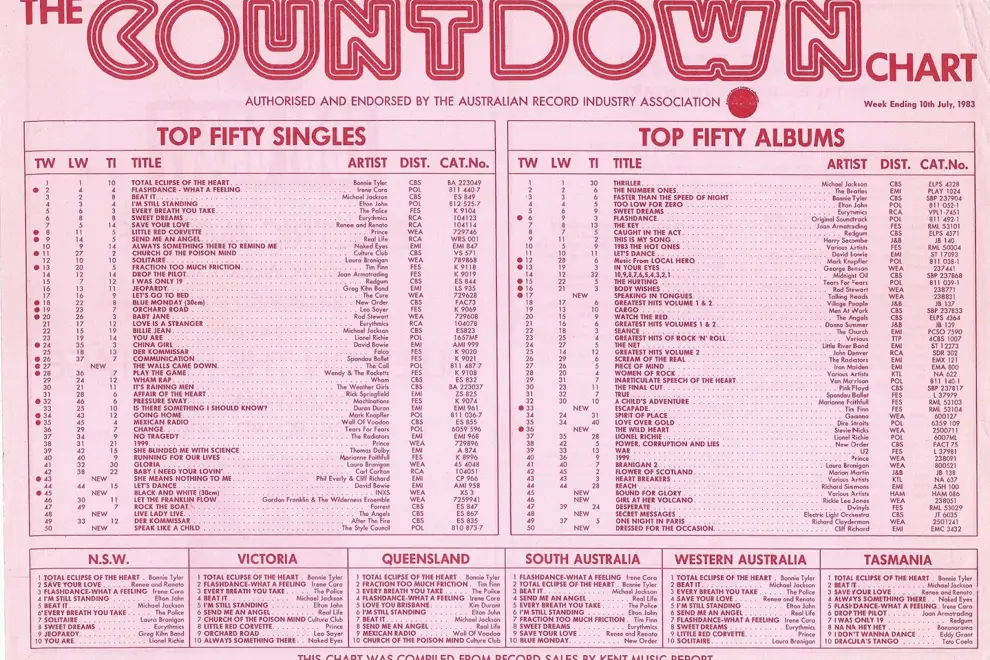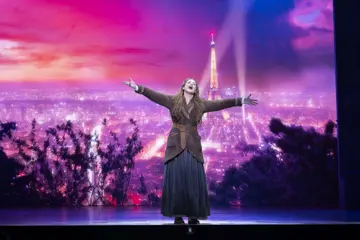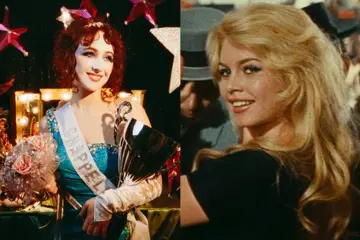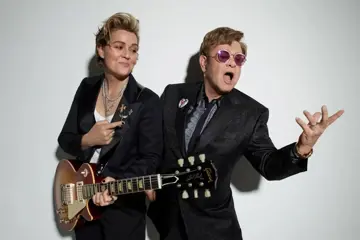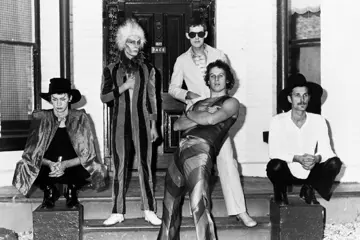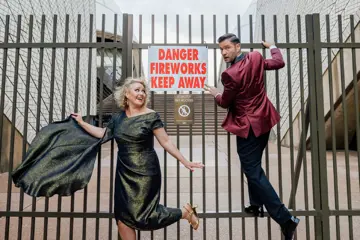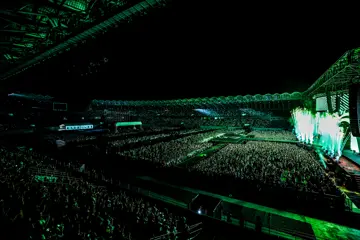 Taylor Swift
Taylor SwiftIf you wandered into a record store 40 years ago today, you would have been greeted by the very first ARIA chart.
Welsh singer Bonnie Tyler had the honour of having ARIA’s first #1 single, Total Eclipse Of The Heart, written and produced by Jim Steinman (with a video directed by Australia’s own Russell Mulcahy). Michael Jackson’s record-breaking Thriller was our first chart-topping album.
Then branded the Countdown Chart, the weekly breakdown was “authorised and endorsed by the Australian Record Industry Association”. The first edition was labelled as reflecting sales for the week ending July 10, 1983, but it was issued a short while earlier on July 4.
So, what does the very first ARIA chart tell us about how the music scene has changed in the past four decades?
Well, the closest thing to a rapper in the first Top 50 was Austrian artist Falco (who made it to #25 on the singles chart with Der Kommissar), and the only act you could reasonably class as country was John Denver, whose best-of album Greatest Hits Volume 2 also clocked in at #25. This week’s charts, by contrast, are dominated by rappers and country acts.
Don't miss a beat with our FREE daily newsletter
The first ARIA chart featured just one collaboration – a single by Phil Everly and Cliff Richard titled She Means Nothing To Me, which debuted at #43 – while this week’s chart features 13. Furthermore, the first ARIA singles chart featured 25 bands in the Top 50, while this week’s features four. When it comes to the albums chart, we saw 21 bands in 1983, and just 11 today. Alongside the rise of the collab, are we witnessing the demise of the band?
The first chart featured ten homegrown hits in the Top 50 – a much better outcome than this week’s chart, which has has just two singles by Australian natives – Vance Joy’s Riptide and Kylie Minogue’s Padam Padam. And the first ARIA chart had ten Aussie albums, while this week’s features five.
Life begins at 40? One can only hope.
Taylor Swift wasn’t born until six years after the ARIA charts started, but now she’s dominating them. This week’s Top 50 features ten of Swift’s singles and nine of her albums – yes, one American woman has five times the number of Australian entries on the Australian singles chart. A Cruel Summer, indeed – and a brutal winter.
The upside is that the charts now reflect more diversity and gender equality. In 1983, the Top 50 singles had just 11 entries sung by women; this week’s Top 50 has 26.
The first singles chart featured 25 acts from the UK, 14 from the US (including one based in the Netherlands) and one Austrian artist. This week’s Top 50 features 31 American songs, 12 from the UK and two from Canada, as well as entries from the Netherlands, Nigeria and South Korea.
In that first chart, Bonnie Tyler sang: “Turn around, every now and then I get a little bit nervous that the best of all the years have gone by.” So looking at this week’s ARIA chart, you can’t help but ponder: was music simply better four decades ago?
Of course, as Van Halen taught us, only time will tell if we stand the test of time. But how many of the songs in this week’s Top 10 will be considered classics, and still remembered 40 years from now, like The Police’s Every Breath You Take, Irene Cara’s Flashdance... What A Feeling, Michael Jackson’s Beat It, Eurythmics’ Sweet Dreams (Are Made Of This) and Real Life’s Send Me An Angel?
Then again, I might just be a dinosaur. As Grampa once lamented in The Simpsons, “I used to be with it, until they changed what it was. Now what I am with isn’t it and what is it seems weird and scary to me. It’ll happen to you!”
For its first chart, ARIA licensed the Kent Music Report, the national chart David Kent started in 1974. It remained the source of the chart until ARIA commenced compiling its own charts in-house in June 1988.
In the ’80s and ’90s, the boss of a major label was fond of telling his staff: “The only thing more important than the chart is oxygen.” But in this streaming age, does the chart still matter? If you asked your workmate, schoolmate or housemate what this week’s #1 song was, do you think they’d be able to tell you it was Sprinter by British rappers Dave and Central Cee?
Melbourne musician and broadcaster Casey Bennetto has called on the ABC to devote ten minutes every Sunday night to count down the Top Ten, right where the old Countdown program would have done the job: at 6:50pm, just before the seven o’clock news. Bennetto is “trying to imagine something that costs virtually nothing but provides an ongoing focus for current music”.
“Before anyone says, ‘Do a full Countdown!’, Countdown is bloody expensive and the ABC clearly don’t have the budget, particularly when the industry itself is this lacklustre.”
He says there’s one flaw in his proposal and “it’s a significant one – the singles market in this country, however they’re calculating it, must be pretty much dead in the water”. Bennetto cites the age of the entries in the Top Ten. This week’s Top Ten has spent a combined total of 165 weeks on the charts; in 1983, it was 75 weeks (though it was a “new” chart, the stats from the Kent Report carried over to the first ARIA chart).
Bennetto highlighted Harry Styles’ As It Was, at #14 this week, marking its 65th week on the chart. “It’s a bit hard to argue that the Top Ten has any relevance at all when a 15-month-old song almost sneaks in.”
Bennetto acknowledges that times have changed. “It just makes me a bit sad to realise that the Top Ten isn’t anything,” he sighs. “When I was a kid, it seemed like everything.” Responding to Bennetto’s Facebook post, industry commentator Paul Cashmere was blunt: “The ARIA chart is useless. It does not reflect culture anymore.”
In 2023, Australia is just an island in the stream. In 1983, music fans were queueing up at record stores to buy a seven-inch single for $2.50. Now they’re clicking on Spotify playlists dominated by international artists – and those streams form the basis of the ARIA chart. It was no surprise that ARIA called its first chart the Countdown chart, because being aligned with the nation’s biggest music show (which ran from 1974 to 1987) gave the chart instant credibility.
“The fall from grace is perhaps more exaggerated in Australia than in similarly sized markets elsewhere because – and it’s not always a cred/fashionable/indie thing to say – the Australia of my childhood had Ian [‘Molly’] Meldrum in it,” Bennetto argues. “Yes, and Suzanne Dowling, Donnie Sutherland, Basia Bonkowski, Lee Simon, later Dylan Lewis and Jane Gazzo, [etcetera]. But let’s not kid ourselves, Meldrum put music at the centre of the cultural conversation and kept it there.”
With TV shows like Countdown and radio shows like Take 40 Australia now just a distant memory, few people seem to care when the week’s Top 50 is quietly posted at 5pm every Friday.
Sadly, in 2023, it’s a total eclipse of the charts.


